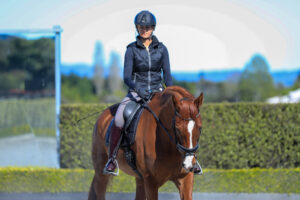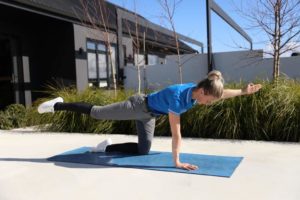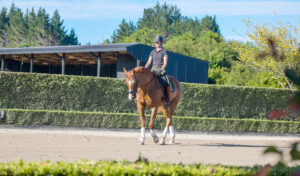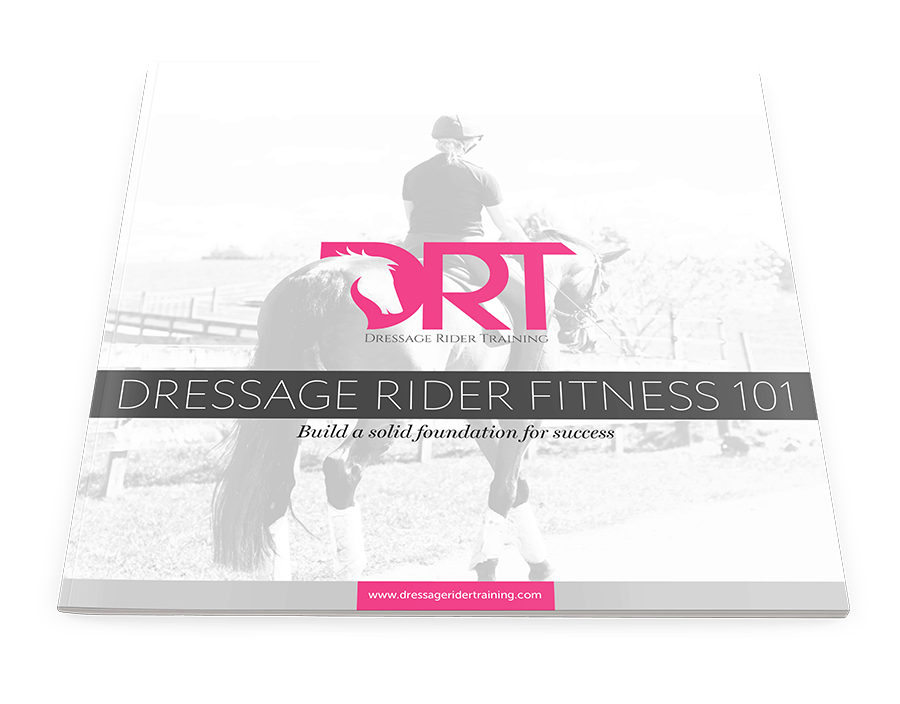8 Key Muscles Involved When We Ride
Learn the key muscles involved when riding and discover the ones needed for good dressage posture.
Before we get into the key muscles, knowing a little about our core is important. Many think of their core as just their six-pack (rectus abdominus), but your core is much more than just your abdominals. It is your entire central unit. Front, back, inside and out.
The core includes muscles that stabilise your spine, pelvis and ribcage. That’s a lot of muscles.
To ensure I give you the best information, I want to share 8 of the key lower half muscles and then check out the next post in this series for the muscles that stabilise your ribcage and upper body here.
What muscles does horseback riding use?
Pinpointing just a few muscles is a disservice to the subtle work our body has to do while we ride. Still, for this article, I wanted to bring attention to some of the key muscles that can affect our posture and balance when we ride and the role that they play when we ride.
Our pelvis plays a crucial role in dressage, and the muscles stabilizing it are important to understand. An unstable pelvis can create an unstable ribcage and shoulder girdle.
This can affect the rider and the horse, from leaning on one rein to having problems bending one way to just bouncing and an inability for the rider to control their body.
Often, it is hard to determine whether it’s the rider or the horse with the issue.
So, it makes sense that as a rider, you take control of what you can control and rule yourself out of the equation. So you can show up and be the best rider for your horse.
You want to understand how the body works and what muscle horseback riding uses to create that still and stable position in the saddle.
The more you can work on your strengths and weaknesses as a rider alongside your horse, the better a picture will be, and the easier your training will be. And the kinder a rider you will be for your horse.
You are a team effort, after all.
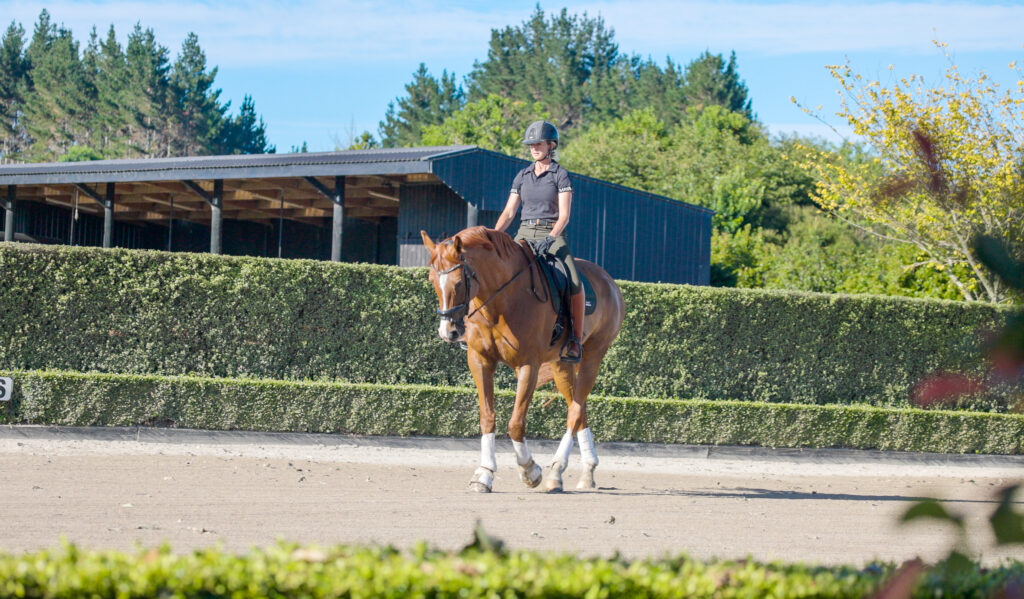
Eight key muscles horseback riders use
Here is a breakdown of eight key muscles involved in horseback riding to create good core stability through the lower half of the core. Mainly helping to stabilize the pelvis and hips.
Transverse Abdominus
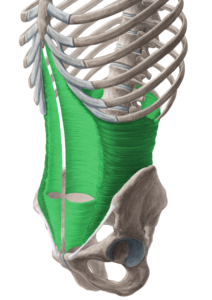
First up, this muscle helps stabilize between your hips, your ribs as well as your pelvis. It’s like the brace that wraps around your centre and protects your spine.
The TVA is the deepest of the abdominals and is often called the “corset muscle” because of how it works and looks.
It works as a stabiliser for your entire lower back.
It’s one of the main core stabilising muscles of the lumbar spine.
A strong TVA helps with core stability and creates a soft, independent riding seat. When our hips can move freely with the horse, it is the role of our TVA to stabilise.
That stability will allow you to remain stable and more balanced in the saddle.
You can read more about the TVA here and get some exercises to help you strengthen it.
Obliques
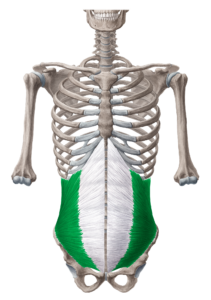
The obliques are the largest of the abdominal muscles. Their function is to rotate, side-bend, and move the trunk.
The oblique’s role in riding comes through stabilisation. One of their primary roles is to rotate; however, in the saddle, they work predominantly by keeping your torso from twisting, so they are used mostly to stabilize and protect your spine.
Picture them by imagining your hand sliding into the front pocket of your jeans; this is the direction of your obliques on each side.
The obliques are vitally important for keeping ourselves evenly stacked upon the horse.
Often, we may collapse through one side. Think of the obliques as the stiff guide ropes holding the sides of your body up evenly.
We need both sides to be equally strong; we commonly have one more compressed or weaker side.
So, working on symmetry through your obliques will help improve your evenness in the saddle.
Psoas
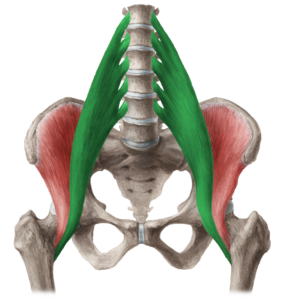
The psoas attach down the last thoracic vertebra and most of the lumbar vertebrae and discs between them from the inside and top of the femur.
It involves flexing your hip and laterally rotating it.
It also has a role in flexing your spine sideways, extending and rotating it. Its big role is the management of the pelvis and controlling the front-to-back motion.
Its role in the saddle is its power to restrict or release the rider’s ability to shock and absorb the horse’s movement. Allowing the pelvis to move with the horse.
The Psoas muscle is often classified as a hip flexor, or you may hear it referred to as the iliopsoas, a combination of the Psoas muscles and the Iliacus.
Until recently, they were often referred to as the same due to similar actions. However, the psoas muscle does much more than flex the hip.
It has a major role in the pelvis and lower back position. The psoas help us control our neutral spine and properly align our lower back.
When your Psoas muscles are tight, it tilts the pelvis forward and lifts it up and away from the flow of the horse’s movement, which may be referred to as a hollow and or braced back.
Also, when the psoas is tight and contracted, it doesn’t have natural flexibility and length, affecting your range of motion and mobility.
Often, a tight psoas muscle means the rider’s pelvis is tipped forward, and this can cause the knee to be pulled away from the horse and the toes to point outwards.
You can read more about your psoas here and it’s the role it plays for dressage riders.
Iliacus

The Iliacus starts from the iliac fossa on the interior side of the hip bone. It joins the psoas major, and the two can often be referred to as the iliopsoas.
Together, these muscles are often called hip flexors. However, I would like to separate them as they have different roles.
The Iliacus muscle is shaped like a triangle, flexing and externally rotating the femur. It plays a key role in maintaining proper body posture in and out of the saddle. Combined with the psoas, they are often considered the strongest muscles in the body.
The Iliacus muscle eccentrically controls the lateral side-bending of the torso, keeping you even and balanced in the saddle.
Piriformis
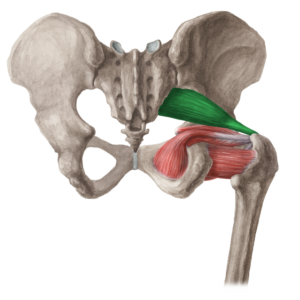
The piriformis is a type of external rotator muscle. It helps rotate the hip outward, allowing the thigh and knee to rotate or move away from the body, such as when stepping to the side from a standing position or getting out of a car.
The piriformis is a muscle deep in the hip that runs near the sciatic nerve. When the piriformis muscle becomes tight and/or inflamed, it can irritate the sciatic nerve.
This irritation leads to sciatica-like pain, tingling and numbness that runs from the lower back to the rear and sometimes down the leg and into the foot.
When riding, this muscle can become compressed and tight, especially if you are riding larger, wider horses. This is why it can be hugely beneficial to understand how to stretch it and include these stretches into your routine.
Because we are bipedal mammals (two-legged), we can do the internal rotation on one side and the complete opposite on the other.
Which is often highlighted when sitting in the saddle. Because most riders aren’t symmetrical, we constantly need to work on this. We can have one side where our piriformis is really tight and the other not so much.
For example, if you have one thigh that adducts (moves inwards) easily compared to the other, this is highlighted once upon a horse and will create an uneven balance on the horse’s back.
You can learn more about your piriformis here and stretches specifically for it.
Gluteus Maximus
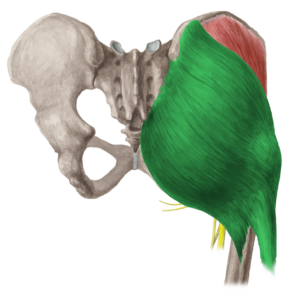
The muscle’s function is associated with the correct pelvic balance and a hip extensor and lateral rotator of the hip and is also involved in the abduction of the hip.
When tight, this can inhibit the horse’s balance, and when weak, this can affect the rider’s balance within the saddle.
It’s a large, powerful hip extensor. The squeezing of the glutes encourages the thighs to activate, which signals a breaking effect.
This is great when you want to half halt and signal to stop, but not so great when sitting to the trot and trying to create freedom through the horse’s back.
Correct functioning glutes help to place your pelvis correctly in the saddle. Part of the problem lies with glutes not being active throughout routine activities, which can make your hamstrings, quadriceps, and calves disproportionately stronger.
All of this can result from too much time spent sitting down, and to put it bluntly, your glutes may have fallen asleep. Tight muscles, specifically the hip flexors, can inhibit the glutes and prevent their muscle fibres from firing. This leads to a pelvis not being correctly aligned in the saddle.
Glutes play a major role in sitting balanced and stable in the saddle. They help support your pelvis and lower back, all moving with the horse and absorbing its movements. So, weakness in the chain can result in these forces being placed elsewhere, like your lower back.
You can read more about your glutes here and exercises you can do to improve them.
Quadratus Lumborum

The Quadratus Lumborum (QL) is the deepest back muscle integral to the thoracolumbar fascia.
The quadratus lumborum muscle is an extensor of the lumbar spine and a stabilizer of the lumbar area. It is also capable of pelvic tilting.
This has a major influence on how you move, stand, and ride your horse.
This lateral flexor controls whether you tip or rock to one side in the saddle. We often become more dominant on one side of our body, weakening the other.
This can lead to crookedness and a feeling of being twisted in the saddle. So, working on both sides evenly is important, especially concerning muscles like this.
Gluteus Medius
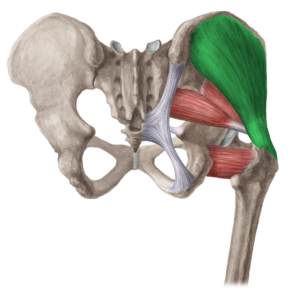
This muscle rotates the hip inward as well as abducts the hip outwards. It is crucial to help the rider stay balanced in the saddle’s centre.
The gluteus medius is located on the lateral aspect of the upper buttock, below the iliac crest.
The gluteus medius plays a crucial role in upholding the stability of the pelvis in the frontal plane. It collaborates with the ipsilateral tensor fascia lata and the quadratus lumborum to create a lateral fascial sling.
The primary function of this sling is stability in the frontal plane. It plays an important role because it prevents the opposite side of the pelvis from dropping. So when walking and a limb is taken off the ground, the pelvis on that side will tend to drop through a loss of support from below.
Gluteus medius maintains the side of the pelvis that drops, allowing the other limb to swing forward for the next step.
So, in the saddle, it plays a role in keeping us even and in controlling how your pelvis moves.
Summary
Now, that is just a small selection of what muscle horseback riding uses and the muscles involved in stabilising your body’s lower half.
Our body works as an entire unit, and there is so much involved in helping to keep your body stable and balanced in the saddle.
Everything is connected.
When you understand the role that the muscles play, you will be able to become more aware of areas that you may need to work on to bring more balance to your body and, therefore, your riding in the future.
I hope you found this useful; you can learn more about balancing your body, improving your core strength and taking your dressage riding to a new level with our dressage rider training program.
Muscles of your hips
When it comes to our hips, its not just about stretching our hip flexors.
We infact have 21 different muscles affecting our hips movement and of course our hip suppleness.
If you want to learn more about the role your hips play in the saddle, we have created a 21-day hip suppleness program for riders.
Here is a snippet from the program. You can find all the information about it here.
Want more articles on improving your dressage? Try these out.
Dressage Rider Exercises For Improved Fitness
6 Dressage Exercises To Help Improve Your Riding Posture
Dressage Rider Leg Strength & 6 Exercises To Help You Improve
Yoga For Dressage Riders & Routine To Improve Your Mobility Before You Ride
All anatomy images used under license from Kenhub GmbH. Illustrator: Nicola Smith.
More articles
Dressage Rider Training Program
Join other participants on our 12-week 'step-by-step' online rider
training program. Improve the 5 components of your riding.
Only available 3x per year.
see full details & register your interest

